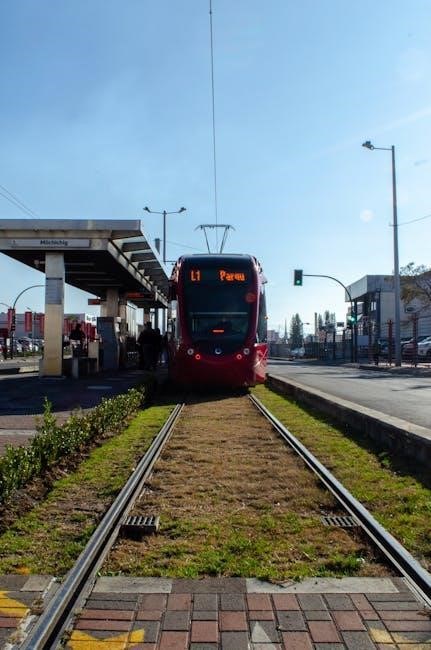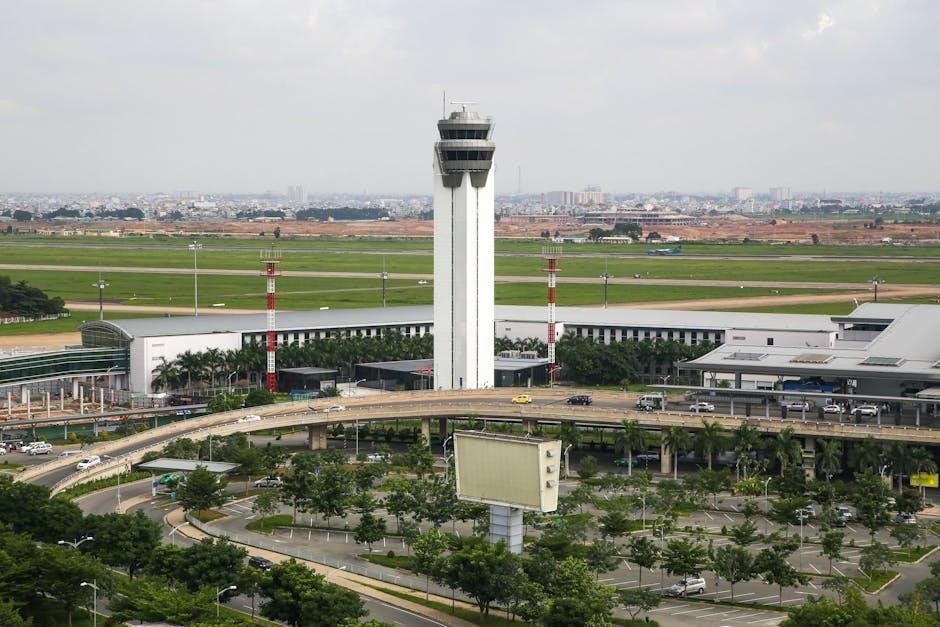
Air traffic control is a critical component of aviation safety, ensuring the efficient movement of aircraft and preventing collisions. Controllers coordinate thousands of flights daily, maintaining safe distances and directing takeoffs, landings, and en route operations. This hidden yet vital field requires precision, quick decision-making, and advanced technology to manage the complexities of modern airspace. Understanding the air traffic control system is essential for appreciating its role in global air travel.
1.1 Importance of Air Traffic Controllers in Aviation
Air traffic controllers play a pivotal role in ensuring the safe and efficient movement of aircraft worldwide. Their primary responsibility is to prevent collisions, manage traffic flow, and guide pilots through takeoff, landing, and en route operations. By maintaining clear communication and precise coordination, they safeguard the lives of passengers, crew, and people on the ground. Controllers must remain vigilant, as even minor errors can have catastrophic consequences. The increasing volume of air traffic demands their expertise to avoid delays and congestion. Despite challenges like high stress and complex systems, their dedication ensures the smooth operation of global aviation. Their work is indispensable, making them the backbone of modern air travel. Without their professionalism, the aviation system would face significant safety risks and operational disruptions, highlighting their critical importance in the industry.

Training and Requirements for Aspiring Controllers
Becoming an air traffic controller requires rigorous training, passing the ATSA test, and completing a pre-employment process. No degree is needed, but expertise in aviation procedures is essential for success.
2.1 Educational Background and Certifications Needed
While a degree is not mandatory, aspiring air traffic controllers must pass the ATSA test and complete a pre-employment process. The FAA hiring process emphasizes skills over formal education. Certification is required, and controllers must undergo extensive training at the FAA Academy. Knowledge of aviation procedures, clear communication skills, and the ability to handle high-pressure situations are crucial. The Aeronautical Information Manual (AIM) is a key resource for learning standard phraseology and protocols. Continuous learning and adaptation to new technologies are essential for maintaining certification and excelling in this demanding field. The role requires a strong understanding of safety regulations and the ability to make quick, accurate decisions. These qualifications ensure controllers are prepared to manage the complexities of modern airspace effectively.
2.2 The ATSA Test and Pre-Employment Process
The ATSA (Air Traffic Selection and Training) test is a critical step in becoming an air traffic controller. It assesses cognitive abilities, situational judgment, and multitasking skills. Candidates must pass this exam to qualify for the pre-employment process. The test evaluates problem-solving, attention to detail, and the ability to handle high-pressure scenarios. Once the ATSA is passed, applicants undergo a background check, medical evaluation, and psychological assessment, including the Minnesota Multiphasic Personality Inventory (MMPI). These steps ensure candidates are mentally and physically fit for the demands of the job. The FAA also reviews work history and personal references. Completion of these stages leads to an invitation to attend the FAA Academy for further training. This rigorous process ensures only the most qualified individuals advance, maintaining the safety and efficiency of air traffic control systems.

Communication in Air Traffic Control
Clear communication is vital in air traffic control, ensuring safety and efficiency. Standard phraseology, as outlined in the Aeronautical Information Manual (AIM), enhances precision and reduces errors, aiding controllers and pilots in maintaining safe operations.
3.1 Standard Phraseology and Terminology
Standard phraseology and terminology are essential in air traffic control to ensure clarity and precision in communication. The Aeronautical Information Manual (AIM) provides detailed guidelines for controllers and pilots, outlining specific phrases for various situations, such as takeoffs, landings, and altitude changes. Consistent use of standardized language minimizes misunderstandings and enhances safety. For example, phrases like “cleared for takeoff” and “descend and maintain” are universally understood, reducing errors. Proper terminology also aids in efficient coordination between controllers and pilots, streamlining operations. Training programs emphasize mastering this language to ensure seamless communication. Misuse of terminology can lead to confusion, potentially jeopardizing safety. Therefore, adherence to standardized phraseology is critical for maintaining order and safety in aviation.
3.2 The Role of Clear Communication in Safety
Clear communication is paramount in air traffic control, as it directly impacts aviation safety. Misunderstandings or ambiguous instructions can lead to errors, potentially causing accidents. The Aeronautical Information Manual (AIM) emphasizes the importance of precise and standardized language to avoid confusion. Controllers must relay instructions clearly, ensuring pilots understand commands without ambiguity. For instance, incorrect altitude assignments or unclear vectors can result in collisions if not communicated effectively. The consequences of poor communication can be catastrophic, as seen in historical incidents where miscommunication led to accidents. Therefore, standardized protocols and consistent terminology are essential to maintain safety. Clear communication not only prevents errors but also enhances situational awareness, allowing pilots and controllers to respond appropriately in high-pressure situations. Its role in ensuring safe and efficient flight operations cannot be overstated.

Tools and Technologies Used by ATCs
Air traffic controllers rely on advanced radar systems, flight tracking software, and navigation aids to monitor and guide aircraft efficiently. These technologies enhance safety and streamline operations.
4.1 Radar Systems and Flight Tracking Software
Radar systems and flight tracking software are essential tools for air traffic controllers, providing real-time surveillance data to monitor aircraft movements. These technologies enable controllers to track flights, predict trajectories, and ensure safe distances between aircraft. Radar systems use radio waves to detect aircraft positions, while flight tracking software processes this data for a comprehensive view of airspace. Advanced systems integrate weather data, navigation information, and communication systems to enhance situational awareness. Predictive analytics within these tools help controllers anticipate potential conflicts and manage traffic flow efficiently. Together, radar and flight tracking software form the backbone of modern air traffic management, ensuring the safety and efficiency of global aviation operations.
4.2 Advanced Navigation and Surveillance Systems
Advanced navigation and surveillance systems are pivotal in modern air traffic control, enhancing accuracy and efficiency. These systems include Automatic Dependent Surveillance-Broadcast (ADS-B) and Multilateration (MLAT), which provide precise aircraft location data. ADS-B enables aircraft to broadcast their position, altitude, and velocity, while MLAT uses ground stations to determine aircraft positions through triangulation. These technologies improve surveillance coverage, especially in remote or mountainous areas with limited radar availability. Additionally, Performance-Based Navigation (PBN) allows aircraft to follow precise flight paths, reducing delays and fuel consumption. These advanced systems integrate seamlessly with radar and flight tracking software, offering controllers a comprehensive view of airspace. By leveraging automation and real-time data, they enhance safety, reduce congestion, and optimize air traffic flow, making them indispensable in the evolution of air traffic management.

Work Environment and Challenges
Air traffic controllers operate in high-pressure environments, managing thousands of flights daily. Challenges include staff shortages, outdated systems, and stress from ensuring safety amidst constant aircraft movements and tight schedules.
5.1 Airport Layout and Traffic Management Systems
Airport layouts are designed to streamline traffic flow, with runways, taxiways, and terminals strategically positioned to minimize congestion. Traffic management systems, including radar and flight tracking software, enable controllers to monitor and direct aircraft movements efficiently. These systems help controllers anticipate and resolve potential conflicts, ensuring safe distances between aircraft. Advanced tools, such as automated decision-making systems, assist in optimizing flight paths and reducing delays. Effective communication and coordination are critical, as controllers must adapt to changing conditions like weather or air traffic volume. The integration of modern technology with experienced personnel ensures the smooth operation of air traffic, even in high-pressure environments. This combination of infrastructure and innovation is vital for maintaining safety and efficiency in busy airspace.
5.2 Managing Stress and High-Pressure Situations
Air traffic control is one of the most stressful professions due to the high stakes and constant need for precise decision-making. Controllers must manage immense pressure while maintaining focus to ensure aviation safety. The job demands quick thinking and the ability to handle multiple tasks simultaneously. To cope, many controllers rely on training, experience, and mental resilience. Additionally, support systems, such as stress management programs and mental health resources, are often provided to help controllers maintain their well-being. Techniques like mindfulness, exercise, and time management are also essential for balancing the demands of the job. Despite the challenges, skilled controllers thrive in these environments, demonstrating remarkable adaptability and composure under pressure. Their ability to manage stress is crucial for maintaining the safety and efficiency of air travel.
 bottom guide for sliding shower doors
bottom guide for sliding shower doors  harvest right troubleshooting guide
harvest right troubleshooting guide  tails noir trophy guide
tails noir trophy guide  san francisco travel guide map
san francisco travel guide map  antenna tv guide austin tx
antenna tv guide austin tx  act math study guide pdf
act math study guide pdf  king of the underworld rj kane pdf
king of the underworld rj kane pdf  merlin home transmitter manual
merlin home transmitter manual  contrat de sous-location québec pdf
contrat de sous-location québec pdf  mark cousins the story of film pdf
mark cousins the story of film pdf